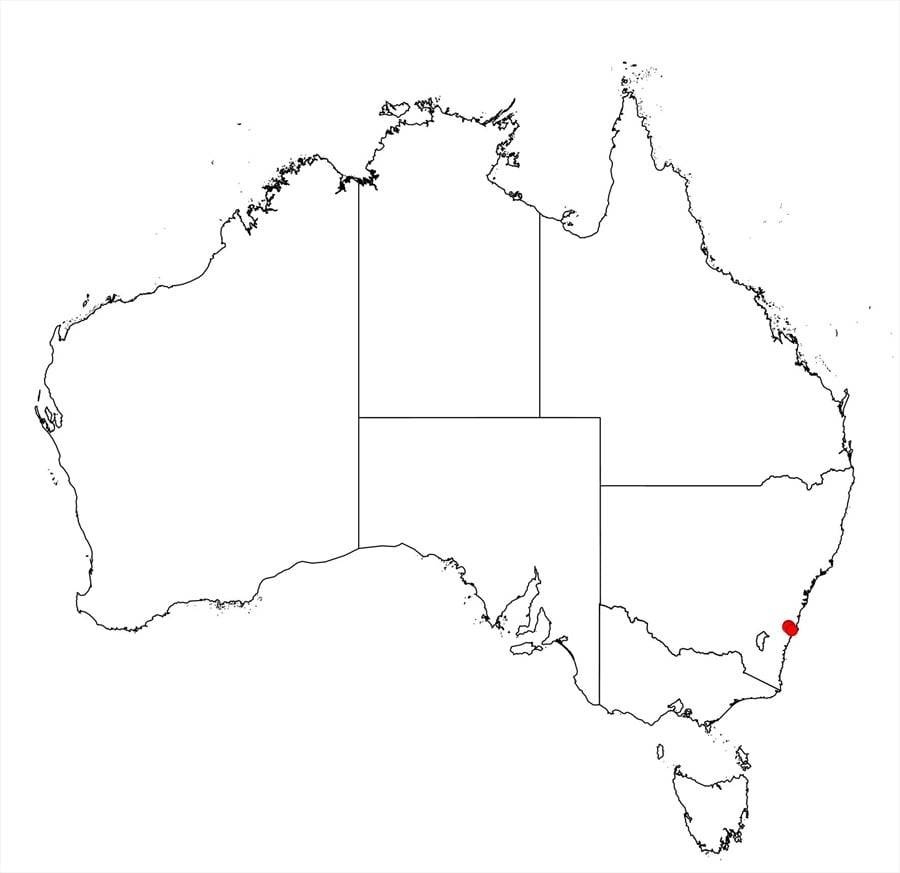Acacia yalwalensis Kodela
WATTLE
Acacias of Australia
Common Name
Yalwal Wattle
Family
Fabaceae
Distribution
Occurs in the Danjera Creek/Yalwal Creek catchment and nearby, including the Bundundah Creek valley, around the old gold mining area E of Danjera Dam, and the site of the former settlement of Yalwal. There are cultivated records from Nowra. See Kodela (2015) for further details.
Description
Erect, straggly or bushy shrub or tree to 9 (–20) m high, often with pendulous branches. Bark smooth or slightly fissured, grey-brown or green. Branchlets terete, slightly angled or flattened towards apices, often pruinose, pilose with fine white-translucent hairs especially on ridges. Leaves with petiole to 0.7 cm long (sometimes obscured by basal pinnae arising from near pulvinus), mostly with a raised, circular to broadly elliptic or slightly obovate gland at base of or near lowest pair of pinnae; rachis (2.5–) 5–12 cm long, grooved above (a shallow, longitudinal groove flanked on either side by a narrow ridge, or appearing like a broad ridge with a shallow groove running down middle), pilose mostly above (with hairs mainly on the ridges either side of groove and on sides of rachis) but sometimes on both sides, with a jugary or ± jugary gland similar to the petiolar gland occurring mostly at the uppermost 1–4 pairs of pinnae (these glands sometimes occur just below to half-way down, appearing interjugary; glands are sometimes present between the uppermost 9 pairs of pinnae, often irregularly so); pinnae (6–) 10–22 (–29) pairs, (1–) 2–4 (–4.7) cm long; pinnules (12–) 20–45 (–51) pairs, oblong to narrowly oblong, (1–) 1.5–2.5 (–3) mm long (rarely to 3.5 mm long), 0.5–0.7 (–0.9) mm wide, dark green above, paler green beneath, ciliate, apex obtuse or acute. Inflorescences in terminal and axillary racemes and panicles. Peduncles (1–) 2–5 mm long, glabrous. Heads globose, c. 9–13-flowered, c. 3–5 mm diam. (when dry), pale yellow or cream-coloured. Pods straight to curved, ± submoniliform (margins usually slightly to moderately, ±regularly to irregularly constricted between seeds), ± flat but discernibly raised over seeds, to 8.5 cm long, 4–6.5 mm wide, coriaceous, brownish black or blue-black, usually ± pruinose, with few, fine lateral veins, glabrous.
Phenology
Flowers chiefly June.–Aug.; fruits Sept.–Jan.
Habitat
Grows in clayey soils and sandy loams, on hill slopes, creek banks and roadsides, commonly with Eucalyptus beyeriana, E. punctata, E. ralla, E. tereticornis, Angophora floribunda, Acacia filicifolia, A. mearnsii, Bursaria spinosa and Olearia viscidula. In a sheltered forest in Sawpit Gully it also grows with rainforest species (K. Mills, pers. comm.). Further details on habitat are provided by Kodela (2015).
Specimens
N.S.W.: 1 mile [1.6 km] W of Cemetery at Yalwal, 18 Sept. 1979, D. Ellison s.n. (NSW); Bundundah Creek, near Yalwal Creek, Morton National Park, 3 Nov. 1987, K. Mills s.n. (NSW); Yalwal, to the W of Nowra, on old town site E of Danjera Dam, 24 Sept. 2014, K. Mills s.n. (BRI, NSW).
Notes
Acacia yalwalensis was previously confounded with Acacia oshanesii F.Muell., as a southern variant with narrow pods and ciliate pinnules. It hybridises with Acacia baileyana.
Diagnostic Features: Specimens of Acacia yalwalensis have previously been identified as A. oshanesii and later recognised as an disjunct informal variant of this more northerly distributed species. Specimens can most readily be distinguished by observing the leaf rachis (a shallow, longitudinal groove flanked on either side by a narrow ridge, possibly seen as a broad shallowly grooved ridge, occurs in A. yalwalensis; a single raised narrow ridge occurs in A. oshanesii), pinnules (ciliate in A. yalwalensis; glabrous in A. oshanesii) and pods (narrower, 4–6.5 mm wide, ±submoniliform with margin more noticeably constricted between seeds and valves discernibly raised over seeds in A. yalwalensis; 7–12 mm wide, ±straight-sided to irregularly and variably constricted between seeds and ±flat or slightly raised over seeds in A. oshanesii). Other differences and affinities are described by Kodela (2015).
Author
P.G. Kodela
This identification key and fact sheets are available as a mobile application:
URL: https://apps.lucidcentral.org/wattle/
© Copyright 2018. All rights reserved.






